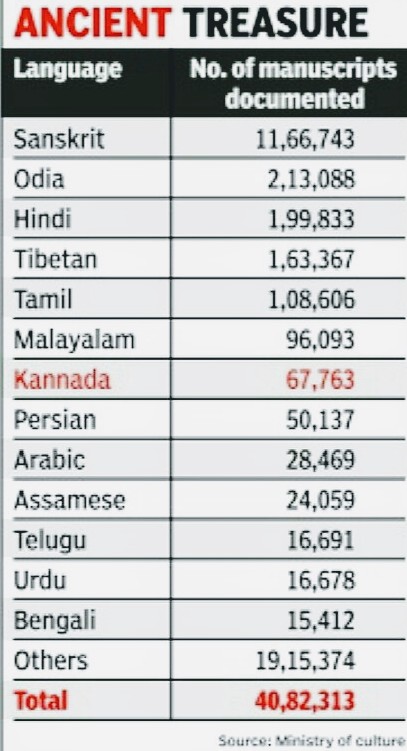Govt. planning law on the protection of Indian manuscript
Context
The National Manuscripts Bill, 2023, is slated to be introduced by the government, according to sources in the Ministry of Culture, probably during the Winter Session of Parliament.
What is the Bakhsali Manuscript and the significance of Zero in the script?
An ancient mathematical text known as the Bakhshali Manuscript was found in 1881 in the village of Bakhshali, close to Peshawar in modern-day Pakistan (historical Gandhara region). It is regarded as one of the earliest Indian mathematical texts still in existence. The text, which is composed of a collection of mathematical rules, issues, and instances given in a mix of verse and prose, is written on scraps of birch bark.
- Discovery: The manuscript was found in 1881 by a villager in the British Indian province of Bakhshali, which is now Pakistan. It is made up of 70 birch bark leaves. The leaves’ intended arrangement is unknown.
- Contents: The Bakhshali Manuscript is a collection of mathematical principles and illustrations covering a range of subjects, including arithmetic, algebra, geometry, and mensuration. The difficulties posed by the cases are then solved, and the results are verified. Numerous mathematical ideas, including fractions, square roots, progressions, equations, and more, are covered in the manuscript.
- Zero Symbol: The use of the zero symbol, which is the first documented instance of the symbol in Indian mathematics, is one of the Bakhshali Manuscript’s most notable aspects. The document features a dot as a stand-in for zero and employs numerals with a place-value system.
- Dating and Debate: Academics have disagreed on the dating of the Bakhshali Manuscript. Carbon dating results from 2017 indicated that the manuscript’s folios, which date from the third to the tenth century, came from several eras and empires. Within the academic world, this raised debates about the reliability of dating techniques.
- Mathematical Context: The Bakhshali Manuscript’s mathematical concepts and rules are comparable to those found in other texts on mathematics from ancient India, such as those by Aryabhata, Bhaskara I, and other authors. The book offers insights into the mathematical methods and understanding of the day.
What is the National Manuscripts Bill, of 2023?
The Indian government has proposed the National Manuscripts Bill, 2023 as a piece of legislation to deal with the protection, documentation, and accessibility of India’s enormous manuscript history. This legislation’s main goal is to create the legal framework necessary for the systematic categorization, digitalization, preservation, and transmission of these priceless historical records. The bill also intends to protect these manuscripts against theft, desecration, and harm, whether they are kept in India or anywhere else.
What are the key features of the National Manuscripts Bill 2023?
- NMA, the National Manuscripts Authority
- The National Manuscripts Authority (NMA) is to be established, according to the bill.
- NMA will have a 10-member board made up of representatives from the government, academia, and industry.
- The NMA will be presided over by the Minister of Culture.
- The NMA’s mandate is to create regulations for the digitisation, conservation, preservation, editing and publication of manuscripts.
- Access and Security:
- The distribution of access to manuscripts shall be governed by NMA.
- It will be able to handle cases including theft, desecration, and damage to manuscripts thanks to its civil court-like authority.
- Collaboration and Scholarships:
- NMA can work with colleges, universities, and other educational establishments to advance scholarship and research about manuscripts.
- It might offer grants and fellowships for reading manuscripts.
- Digital Portal:
- To index, categorize, upload, and download manuscript information, NMA will set up a special digital gateway.
- Researchers and the general public will have easier access to manuscripts thanks to this service.
- Acquisition of Manuscripts:
- Given their rarity and historical significance, the NMA has been permitted to purchase manuscripts from individual owners.
- An expert committee will choose the purchasing price.
- linguistic diversity:
- The estimated 10 million manuscripts of India’s manuscript history are written in 80 different ancient scripts, including Brahmi, Kushan, Gaudi, Lepcha, Maithili, and others.
- These writings span a wide range of subjects, including astrology, literature, agriculture, history, and religion.
- NMM, or the National Mission for Manuscripts:
- The NMM, a separate entity under the Culture Ministry, is in charge of looking after India’s extensive collection of manuscripts.
- A sizable number of manuscripts have been digitized as a result of NMM’s digitization work.
- Interest on a global scale and sociocultural importance
- The law highlights the rebirth of the socio-cultural relevance of ancient manuscripts and acknowledges the possibilities for tying the study of manuscripts to a means of support.
- It is anticipated that increased global interest in Indian cultural heritage will result from the documenting of Indian manuscripts overseas.
What are the advantages of the bill and its impact on the educational field?
- Preservation of Cultural History: The bill makes provisions for the protection of India’s rich textual history, ensuring that historical, cultural, and intellectual assets are preserved for future generations.
- Centralized Management: The National Manuscripts Authority (NMA) was established to manage manuscripts in a coordinated and organized manner, facilitating preservation and digitization operations.
- Digitization and Accessibility: The bill places a strong emphasis on digitization and the development of a digital portal, making manuscripts available online and allowing researchers and the general public to interact with these texts remotely.
- Global Outreach: Because scholars and researchers from all over the world can study and contribute to our understanding of India’s cultural and historical legacy, online accessibility promotes global interest and collaboration.
- Protection from Desecration: The legislation gives NMA the power to take legal action against crimes like theft and desecration, safeguarding manuscripts’ integrity and preventing any potential harm.
- Acquisition from Private Owners: The National Manuscripts Archive’s capacity to purchase manuscripts from private owners protects priceless manuscripts and averts their loss due to neglect or ownership changes.
In conclusion, the historical significance of the Bakhshali manuscript and the proposed National Manuscripts Bill, of 2023, show India’s dedication to maintaining its extensive manuscript history. The National Manuscripts Authority was established, collaboration attempts were made, digital cataloguing was done, and scholarly involvement was encouraged. These actions illustrate the entire strategy for preserving and promoting these priceless manuscripts.





